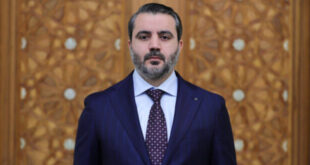Damascus, SANA- Culture Minister Issam Khalil affirmed that beheading of former Director of Palmyra branch of the department Khaled al-Asaad by the Islamic State in Iraq and Syria “ISIS” reflects inherent hatred of humanity and human values.
The minister said in a statement to SANA that the Culture Ministry denounces in the strongest terms this horrible crime, calling on international organizations to shoulder their responsibilities towards Syrian bloodshed by terrorist organizations which are supported by well-known regional and international countries.
He expressed sincere condolences to al-Asaad family and all Syrian people over the irreparable loss of a world-renowned antiquities scholar.
Director of the General Department of Antiquities and Museums condemns the crime
Director of the General Department of Antiquities and Museums Maamoun Abdul-Karim condemned the beheading of al-Asaad byISIS.
Quoting local sources in Palmyra city, located in the central Homs province, Abdul-Karim told SANA that ISIS terrorists beheaded in cold blood the 80-year old archeologist in the National Museum Square in the city and later crucified his body and hung him on colonnades in central Palmyra.
He added that ISIS had repeatedly interrogated al- Asaad to try to force him to give information about the places of specific archeological treasures in Palmyra but to no
avail, and then they killed him.
Abdul-Karim described al-Asaad as one of the most prominent Syrian pioneer archeologists in the 20th century.
Speaking of the course of his career, Abdul-Karim said al-Asaad headed the Department of Palmyra Antiquities and Museums between 1963 and 2003. After retirement, he worked as an expert at the General Department where he participated in developing scientific archeology strategies.
The late archeologist accomplished great achievements in terms of restoring a large number of archeological pieces and artifacts as well as participating in scores of national and joint excavation expeditions, mainly in Palmyra.
Born in Palmyra, al-Asaad participated in Palmyra Development Project between 1962 and 1966, as he unearthed the largest part of the Great Colonnade and the Great Tetrapylon of Palmyra and some of the Byzantine cemeteries, caves and tombs.
Al-Asaad worked at a number of Arab, regional and international institutions like the United Nations Educational, Scientific and Cultural Organization (UNESCO), the European Commission and EU in the framework of projects related to Palmyra and the Syrian ruins.
ISIS took over Tadmur city and the archeological site of Palmyra-a UNESCO World Heritage Site- in May, killing hundreds of the locals and putting in jeopardy a most treasured part of Syria’s archeological heritage.
Last July, ISIS terrorists destroyed the 1,900- year-old Lion of Al-Lat statue, one of the most important archeological statues in Palmyra.
ISIS also killed many antiquities and archaeology workers, whose number has reached 13 in various Syrian provinces.
H. Zain/ H. Said/ Manar/ Mana/ Barry
 Syrian Arab News Agency S A N A
Syrian Arab News Agency S A N A




